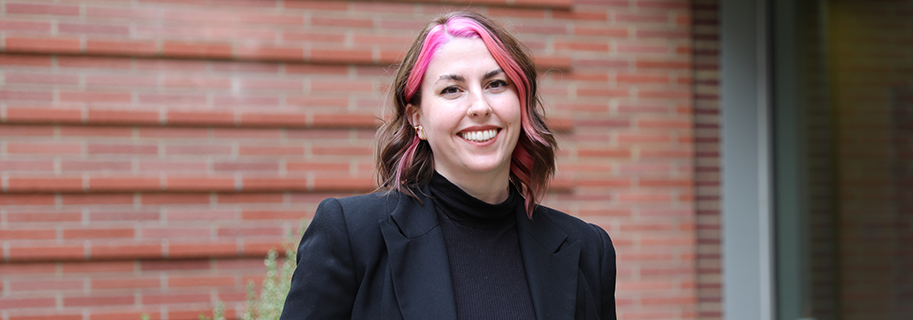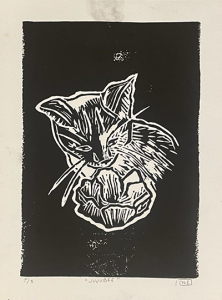
Q&A with Professor Carissa Eisler
Carissa Eisler ’10 is an assistant professor in the Department of Chemical and Biomolecular Engineering at the UCLA Samueli School of Engineering. She received her B.S. in Chemical Engineering from UCLA Samueli, and her M.S. and Ph.D. from Caltech. Before coming to UCLA, she was a postdoctoral scholar at UC Berkeley. Eisler is a recipient of the NSF Faculty Early Career Development Award (2023), Northrup Grumman Excellence in Teaching Award (2023) and UCLA Society of Hellman Fellows Award (2021).

At the intersection of photonics and chemistry, Eisler’s research integrates optical design, materials chemistry and transport phenomena to understand the complex propagation of light and energy through nanostructured materials. She is passionate about teaching and mentoring the next generation of scientists and engineers who will address the interdisciplinary challenges of global energy usage and production. In her free time, she enjoys hiking, print-making and obsessing over her two cats, Jujubee and Louise.
“Since starting at UCLA, I have learned so much about active learning activities from our organizations like the Center for the Advancement of Teaching (CAT) and the Center for Education Innovation and Learning in the Sciences (CEILS).”
Q: What are some of the main research projects that you are focusing on in 2023-2024?
A: One of the areas we are focusing on is to elucidate the fundamental photo physics of new and interesting nanomaterials. By shrinking material dimensions to the nanoscale (1-100s nanometers), we alter how electrons and photons both are generated and move through these materials, which can lead to really exciting (and sometimes strange) optical phenomena. In this area, we are developing new characterization techniques to quantify the momentum (direction of movement) and time scales of photons in perovskite nanocrystals so that we can understand how nanocrystal shape, alignment, environment, and surface chemistry all connect to the extraordinary optical phenomena that has been observed.
Another area we are focusing on is using the anisotropic light emission properties of nanoparticles to address our energy generation and usage challenges. The efficiency of every optoelectronic device is dictated by the angular distribution of light and energy, so using highly directional and highly tunable light emitting materials can allow us to make significantly more efficient light emitting diodes and displays, solar modules, and communication and computing architectures. In the next year, we hope to demonstrate proof-of-concept light concentrator structures that can lead to enhanced solar energy conversion.
Q: How do you work with undergraduate and graduate students on these research projects?
A: I believe that mentorship works most effectively with a balance of structure and creativity. My graduate students and I have “big picture” meetings a couple of times during the year to plan out our research goals for the quarter and determine what the big steps are in order to achieve them. Then, each of my graduate students and I meet one-on-one every week to collaborate on and troubleshoot the day-to-day activities. I believe having structured goal setting helps to give a general direction but still allows for the freedom to explore and try new things, which is important for growth and new discovery. I really enjoy it because all of my students are super bright and creative people and are always bringing new ideas that I wouldn’t have been able to imagine on my own.
I feel very lucky that my graduate students agree that undergraduate research opportunities are of high importance. We are always hosting undergraduate researchers and work with formalized programs like the Summer Undergraduate Research Program (SURP) and E-87 course through the Center for Excellence in Engineering and Diversity (CEED). My graduate students and I collaborate on how we design projects for the undergraduate researchers in the same way, balancing big picture goals with increasing amounts of freedom as the undergraduates become more experienced and confident in the lab. Additionally, it gives my graduate students the invaluable experience of how to be an effective mentor and foster the development of early career researchers.
Finally, cooperation is a huge theme in our lab. Our weekly group meetings consist of one student (undergraduate or graduate) leading a discussion on their recent work and/or relevant literature. It’s a precious time for our group because we are able to celebrate our successes and support each other during our challenges. This also couples with our group belief that equity, diversity and inclusion are necessary to the advancement of our program, so we use these group meetings to also discuss ways to make the group a welcoming and equitable place for all.
Q: How will your research be translated into new technologies?
A: By controlling what direction light is emitted, we can greatly improve the efficiency of any optoelectronic device that find, detect and control light. For example, in light-emitting diodes (LEDs), we want the generated light to be coupled out of the device to light up our room. However, there are lots of loss pathways in which light could be emitted at a high angle and trapped within the layers that make up the device, eventually being lost as heat. Thus, if we only allow our materials to emit light in specific directions, we can avoid these losses and improve the efficiency. This can be generalized to many applications, such as displays and solar energy modules, as well as novel technologies, such as optical computing and data storage.
Q: How could private funding through donor gifts enable you to further your research at UCLA?
A: Private funding through donor gifts allows us researchers to tackle society’s most pressing challenges while fostering the development of the next-generation researchers in our students. Our most pertinent (and most interesting) scientific questions are often at the intersection of many disciplines, which necessitates good support to tackle the intricacies of these challenges and big questions. Additionally, it’s important that we train our graduate and undergraduate students to apply the knowledge from their degrees to these issues so that they feel ready to take on the challenges of tomorrow.
Q: How did you come up with “Think-Pair-Share with a Real-Time Polling Twist”? And why did you feel the need to innovate this new method in your teaching style?
A: This activity is the result of a wonderful collaboration with Prof. Glory Tobiason from the Department of Education. Since starting at UCLA, I have learned so much about active learning activities from our organizations like the Center for the Advancement of Teaching (CAT) and the Center for Education Innovation and Learning in the Sciences (CEILS). I had found “think-pair-share” particularly helpful in my classes because it forced students to stop passively engaging with material in order to analyze a posed question (think), discuss their reasoning with their peers (pair), and discuss findings and pain points with the whole class (share). Over the pandemic, I started incorporating polling software into my lectures so students could anonymously share their votes and thoughts after the paired discussion, which allowed me to hear from more voices in the class. I wanted a way to push this activity even further with this now widely available technology and, because Glory and I love to talk about pedagogy, she helped me develop the idea of polling students before and after their discussions. I hoped this would lead to better conversations between the students and to have more students feel confident to “share” their answers with the whole class.
Q: How did you feel when former Interim Dean Dunn notified you that you had been awarded the Northrop Grumman Excellence in Teaching Award?
A: I felt immensely honored and deeply grateful for the recognition. I felt very emotional after Interim Dean Dunn notified me because it felt like a very “full circle” moment. I had chosen UCLA as an undergraduate student because I felt like the school really cared about education in addition to research excellence. One of my now colleagues in the department, Prof. Jane Chang, was my favorite instructor and really helped set me on the path to academia. It felt really significant to reflect on how I was now being recognized for my role in education because it had such an impact on my own journey.
